Learning how to raise pigs for meat is a great option for any homestead or farm wanting to become more self-sustainable. But choosing the breed and tailoring the care takes a bit of know-how. Read on for 12 tips for raising pigs for meat.
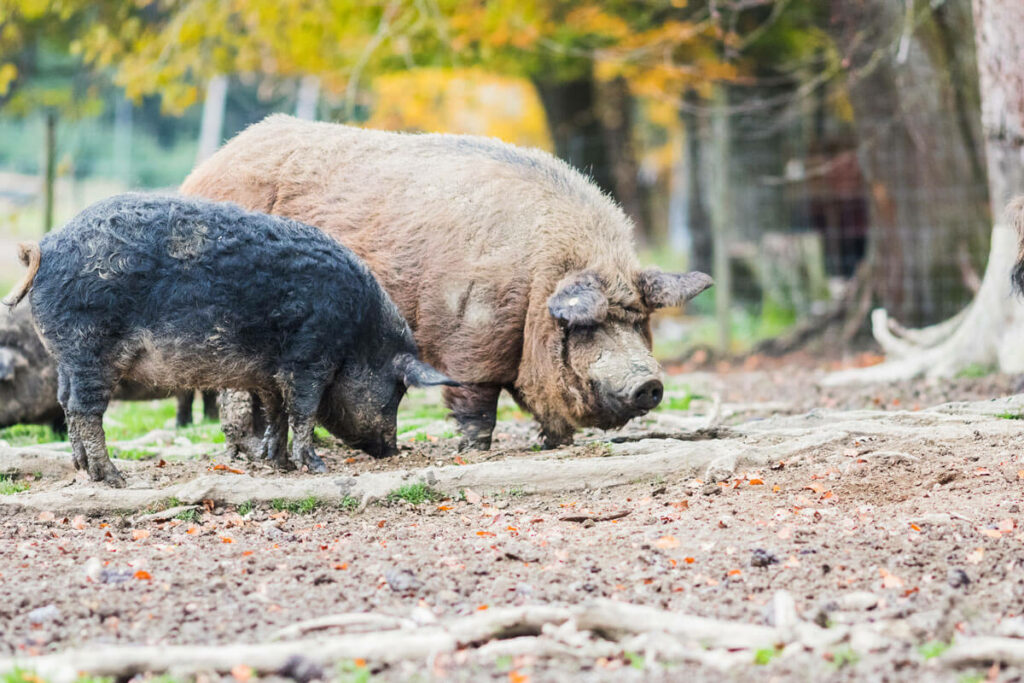
This post was originally written and published in 2015 by Amy from Autumn Creek Ranch and has since been updated to include my interview with “Pork” Rhyne Cureton for even more information. Enjoy!
In previous podcasts I’ve discussed how I raised American Guinea Hogs and why we chose that specific breed. And in another podcast I discussed whether or not we thought the Guinea Hogs were worth it to raise for meat, including whether or not we’ll raise them again.
Today’s podcast guest (Pioneering Today Podcast episode #331) is “Pork” Rhyne and I was fortunate enough to have met him at the Homesteader’s of America Conference. I couldn’t wait to get him on the podcast to discuss all things pigs!
“Pork” Rhyne works as an international agricultural educator and niche-meat marketing expert. He’s dedicated his life to training and educating experienced and beginning farmers on business and marketing. (Read to the bottom of this post on where you can find Pork online!)
If you’re not at a point where you’re ready to raise your own meat, namely pork since that’s the topic of the day, I want to recommend Butcher Box.
Butcher Box happens to be a sponsor of the Pioneering Today Podcast and they have a special going on now through Jan 20th, 2022 called the New Year’s Bundle. In this bundle, for first-time subscribers only, you will get 7 lbs of meat for FREE in your first box! Go to butcherbox.com/pioneeringtoday to sign up!
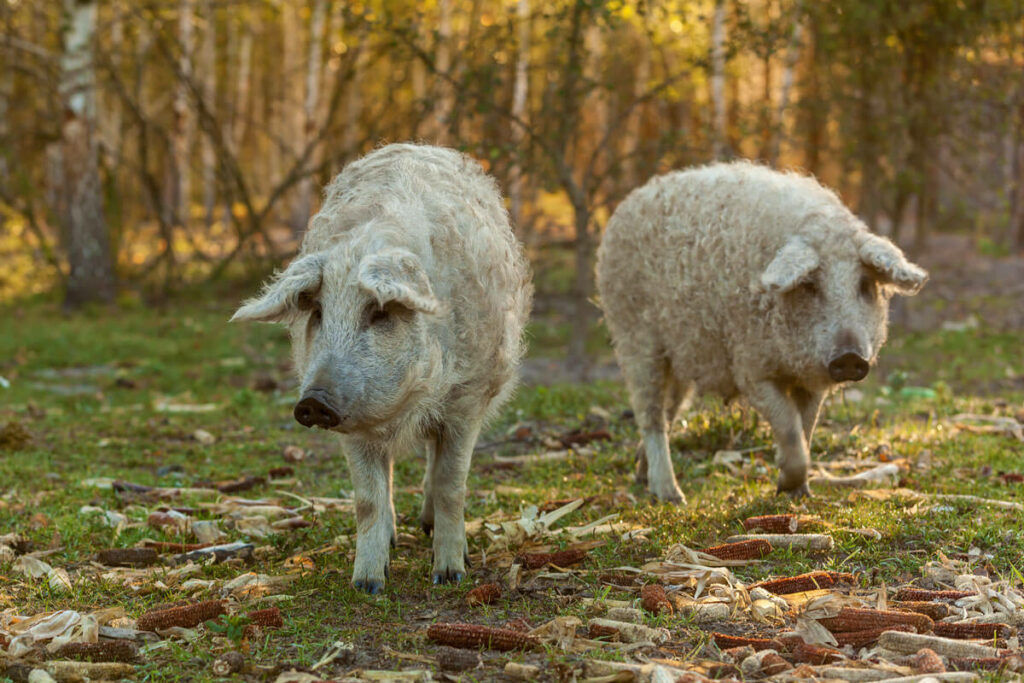
Why I Love Raising Pigs
I really think pigs are one of the easiest animals to raise on a homestead. They mature quite a bit faster than a beef cow and render way more meat (and lard) than a chicken or rabbit (and frankly pulled pork, fresh bacon, lard rendered at home, and salt-cured hams are just amazing!!!).
Other Animals to Raise
Before jumping into raising pigs, for more information on raising your own meat, be sure to check out this post on planning your livestock and raising enough meat for a year’s worth of food. As well as the following for other animal-specific posts:
- Raising backyard egg-laying chickens
- Raising backyard meat birds
- How to raise a dairy cow
- Raising meat rabbits
- Raising sheep (for fiber)
- A guide for raising goats
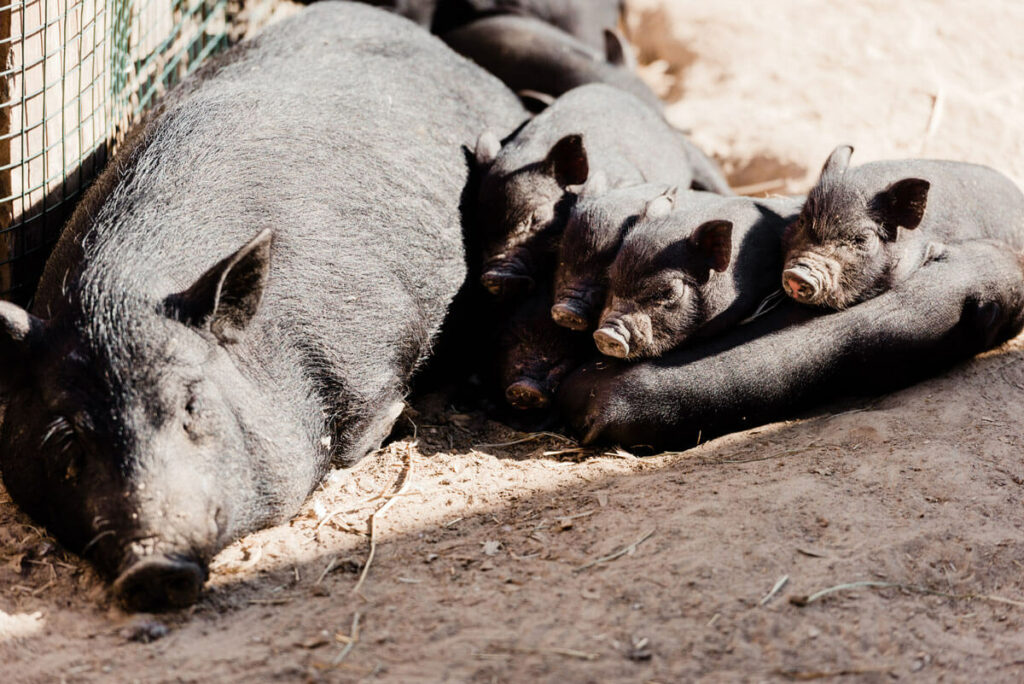
12 Tips for Raising Pigs
So maybe you have thought about raising a pig (or two) and don’t know where to start? Here are some tips and pointers I hope will help you on your way to raising your own delicious pork.
Buy Piglets
For someone interested in just raising a few pigs a year for meat it’s easier to buy piglets than raise your own breeding stock.
Piglets vary in price due to location, time of year (they are more expensive in Spring when kids in 4-H are trying to find them), and by breed.
At the original time of the writing of this post (2015) piglets were being sold for about $125/each but they could be found as low as $75 depending on market demand. (Prices are likely higher now.)
Age Matters
The industry standard for selling baby pigs is 6 weeks of age. However, we sell our piglets at 8 weeks of age because we find that piglets allowed to remain with the sow those two extra weeks have stronger immune systems and do not need to be fed starter feed.
Of course, that means we have to feed the sow extra to keep up her condition but we think healthier piglets are worth it.
If you can find piglets that have been allowed to nurse a bit longer it’s worth the extra cost as it will save you in both your feed bill as well as potential health concerns for the piglet.
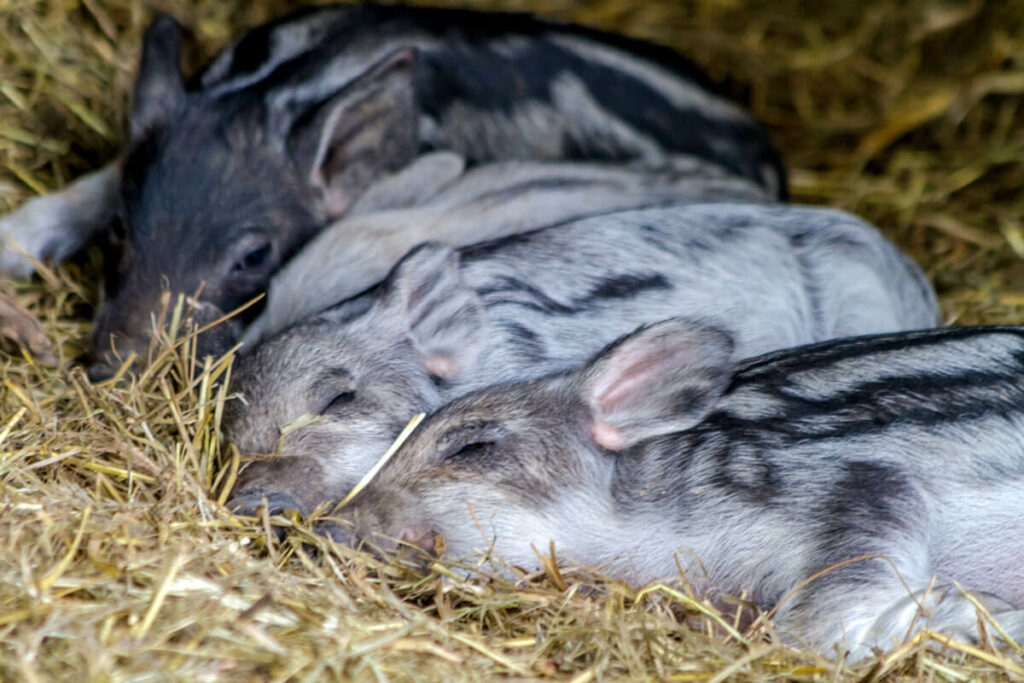
Space Considerations
Before you bring home piglets you need to have a pen and some sort of shelter for them. I will talk more about fencing in a minute but there are some considerations to take into account when planning your pen.
If the pen is small, the piglets will grow faster because they will not have as much room to exercise and the ground can get really destroyed.
Also, in a smaller area, parasites have more of a chance to grow. Finally, a small pen in the Spring when the weather is wet can result in a great big mud pit.
However, as Pork Rhyne discusses in the podcast interview, this doesn’t mean you must have space to free-range or pasture your pigs. Raising your own pigs is a huge step up from buying commercially-raised pork products, even if you don’t have the ideal living conditions for those pigs.
We prefer to use rotating areas in the warmer months and really large areas closer to the house in the colder months (we actually put pigs on our garden areas during the winter so they can till them up and fertilize them in preparation for Spring planting).
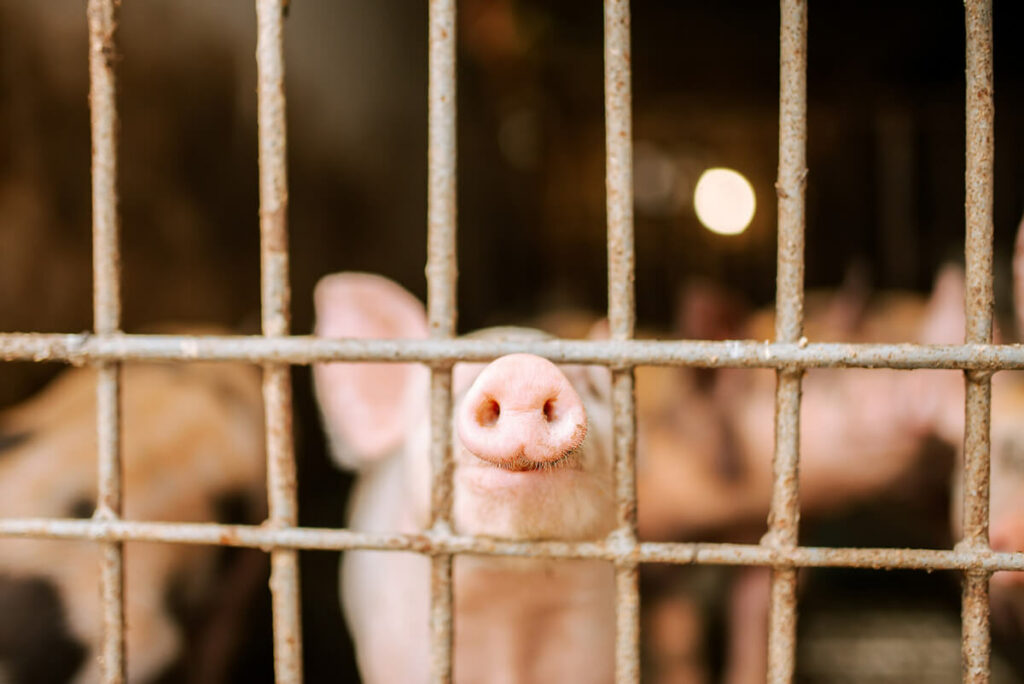
Fencing
When piglets are young, it’s better for them to be in a cattle panel, hog panel, or pallet pen.
Electric netting, string, or wire don’t work well with small piglets because they can get out (spoken from lots of experience and a piglet that took off for two weeks in the surrounding woods of our property).
We keep piglets in a small cattle panel pen with electric wire on the bottom until they are about 12-15 weeks old and then we transfer them into pens made with electric string or wire until they reach butchering weight.
Usually, by 12-15 weeks they are trained to the electric and are large enough not to mess with going through it. It’s good to have an exit way or gate that is not electric, however. Pigs can be so well trained to electric fencing that when we want to move them they will not go near a place that there USED to be electric fencing.
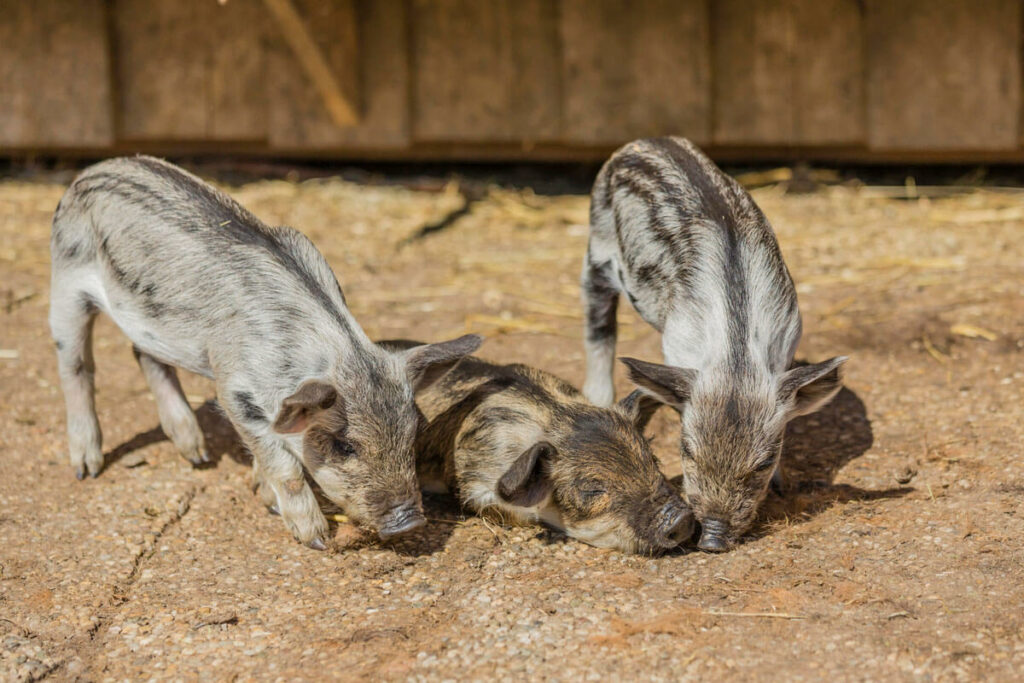
Feeding Pigs
There are lots of possible ways to feed your pig. The easiest is to buy a commercial hog grower. Pigs grow fastest on this type of ration. Unfortunately, most commercial hog grower formulas contain corn and soy which is likely GMO.
A lot of commercial feeds also contain medications which may nor may not be needed for your particular animal.
Since we don’t like giving medication unnecessarily to our animals, another option is to make your own feed from a grain and protein source or find a natural pre-made feed in your area.
Here’s what Pork Rhyne has to say about feeding pigs… There’s so much controversy on what to feed your pigs, everything from going to your local bakery and feeding pigs day old bread, to only buying the best, organic, non-GMO feed.
There are so many people who are just starting to raise pigs who don’t actually know what a healthy pig looks like. So he recommends spending time with someone else who raises pigs to learn and get acclimated to how much pigs should eat, how their appetites vary based on the seasons, and what a healthy pig looks like.
We homesteaders love the alternative route, anytime we can DIY or have an alternative way of doing something, we’ll jump on it! I think it’s in our nature. But before diving into making your own pig feed, it’s important to understand the components of feed to know how to feed a pig in order to get a product with a fat:meat ratio you’re happy with when it comes time to butcher.
- Carbs – energy source, oftentimes corn or grain
- Protein source – soy beans, field beans, etc.
- Fiber/Minerals/etc – these will make up the rest of the feed to help keep the pigs healthy
Once you have the basic components of the feed down, it’s also important to know about your specific breed because each breed will have different carbohydrate and protein needs.
When it comes to American Guinea Hogs, they’re obesity prone so they need a lower carbohydrate diet to avoid getting too much fat on the hogs.
Pork Rhyne had a friend who was really disappointed with the amount of meat to fat ratio he got after butchering his pigs, but it turns out that he was feeding his pigs 16% crude protein throughout their whole life instead of reducing the protein prior to butchering.
Typically, about 2-3 months before slaughter, Pork Rhyne recommends reducing the amount of protein down to 12-14% and increasing the amount of carbohydrates to turn that energy into fat.
As I said above, this all varies between breeds and is different for herefords, heritage breeds, commercial breeds, etc.
In addition to pre-made feed, pigs love all types of produce. You can even grow crops specifically for your pigs like mangels, forage turnips, beets, and pumpkin.
On our farm, we feed a locally sourced barley and peas combination with added swine minerals. Our pigs also get lots of fresh milk, table scraps, local apples and pumpkins.
Please do not feed your pigs bakery scraps and the like and expect a healthy pig with great tasting meat. You eat what your pig eats so quality matters.
Another example of ways to feed pigs is that Pork Rhyne has a friend who has gone to Chipotle (the fast-food restaurant chain) and picked up beans that weren’t sold to consumers to feed his pigs.
I’m all for being resourceful! Just be sure the food you’re getting is not post-consumer (meaning it wasn’t served first to a customer, then thrown in the trash because that will spread diseases to your pigs) and be sure there’s no pork in the product.
One thing I love to do is to source my feed as locally as possible. We have a granary that’s about an hour away that has a non-GMO stance, and also tries to source their grain as locally as possible as well. For money saving tips on purchasing from your local granary, check out Stocking Up on Animal Feed (+ How Much to Feed Animals).
Also know, if you’re feeding your pigs spent grain (like brewers grain you might get from a brewery), about 80% of it is water. For example, if that grain was dry, it would contain about 29% protein, whereas once the grain is wet (or spent), it only contains only 7.7% crude protein.
Spent grain also gets moldy very quickly, so Pork Rhyne recommends this as an addition to a diet, not the primary source.
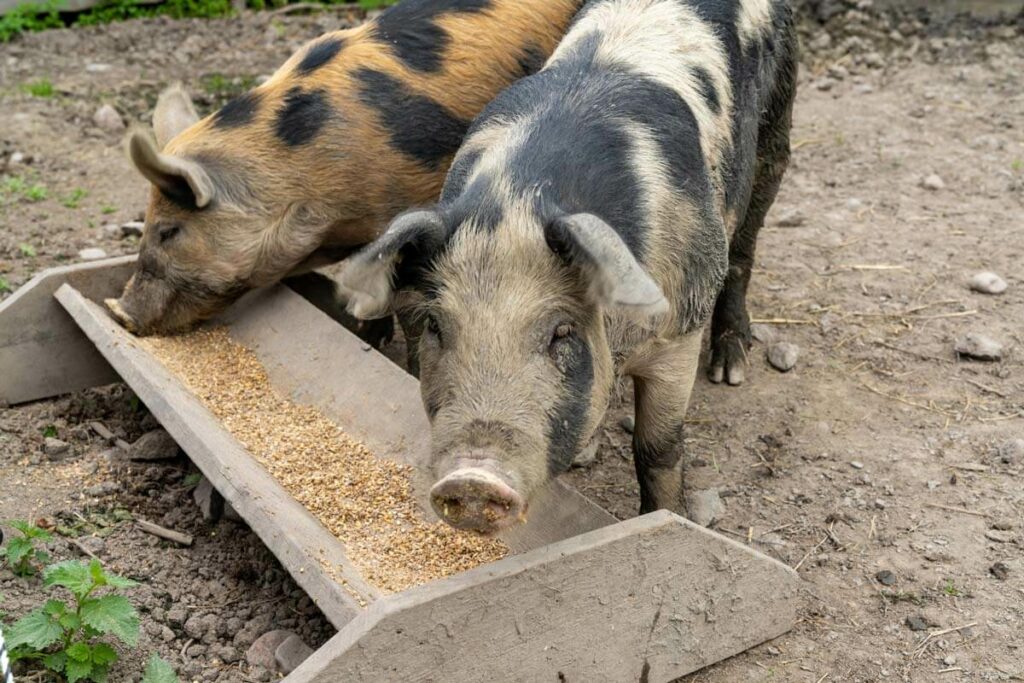
Demand vs. Measured Feeding
Another thing to consider when raising pigs is whether to set up a self-feeder and let the pigs eat whenever they want or feed them a set amount each day.
There are pros and cons for both. Demand feeding makes the daily workload smaller except on the day when you have to fill the pig feeder. Also, if pigs always have food available they will be less likely to root as much and so your ground stays in better shape. Pigs who are demand-fed also tend to grow faster so your time to maturity is less.
The problem with demand feeding is that pigs can eat a LOT of food and this can get expensive, especially as the pigs get older.
We have found that if you are only raising one or two pigs demand feeding is the way to go. When you are raising 10 or more is when it can become cost-prohibitive.
We give each of our piglets 5 lbs of their grain mixture each day. In addition to this, they get milk, table scraps, and produce.
This allows us to have market weight pigs at around 8 months or so.
Medicines & De-Worming (DIY De-Wormer)
I am not a fan of chemical de-wormers because of the mutations and resistances they create.
On our farm, we have found garlic to be a much more effective de-wormer anyway.
We add approximately 1 lb of garlic granules to one ton of feed.
In addition, oregano oil is also superb at fighting parasites and infection.
Finally, we keep geranium essential oil handy for bleeding (pigs can get in scuffles) and tea tree oil for cuts and scrapes.
To Castrate or Not?
Castrating pigs is a controversial issue. There are many who find the practice cruel and unnecessary but others who say it needs to be done to prevent boar taint.
If you are raising two male pigs you will need to determine whether you want to have this procedure done.
However, when you are raising piglets of the opposite sex it’s wise to go ahead and castrate. When we first started raising piglets we were told they wouldn’t start to breed until they were 9 months old. Since we butcher at 8 months we didn’t think we needed to castrate.
Bad advice and we ended up with pregnant market pigs. We now castrate all male piglets raised for meat. We have found Bach’s Rescue Remedy very helpful in the process – it keeps both pigs and the person doing the castration calm.
Breeds Matter
Different breeds of pigs have different qualities, including differences in size, meat quality, and temperament.
These are things you will want to investigate when choosing your piglets prior to bringing them home.
We raise heritage breeds of pigs (Gloucester Old Spot, American Guinea Hog, Tamworth) because of their docile and friendly temperaments and excellent meat quality.
The American Guinea hog is a much smaller breed of pig and will not yield a conventional carcass weight but because of their easy handling ability and chef-quality meat, it’s a tradeoff we are willing to make.
Pork Rhyne’s first pigs were actually a heritage breed called “large blacks” and “red wobble”, he’s also raised some crosses and commercial pigs.
200 years ago pigs weren’t getting fed the diets they now get. They were low-input animals, just like chickens, where they were getting fed scraps from the kitchen or garden, free-ranging and ruminating, etc.
For many years, pigs were the “fail-safe”. If a crop had a bad harvest one year, families would always have pigs to sell to make ends meet.
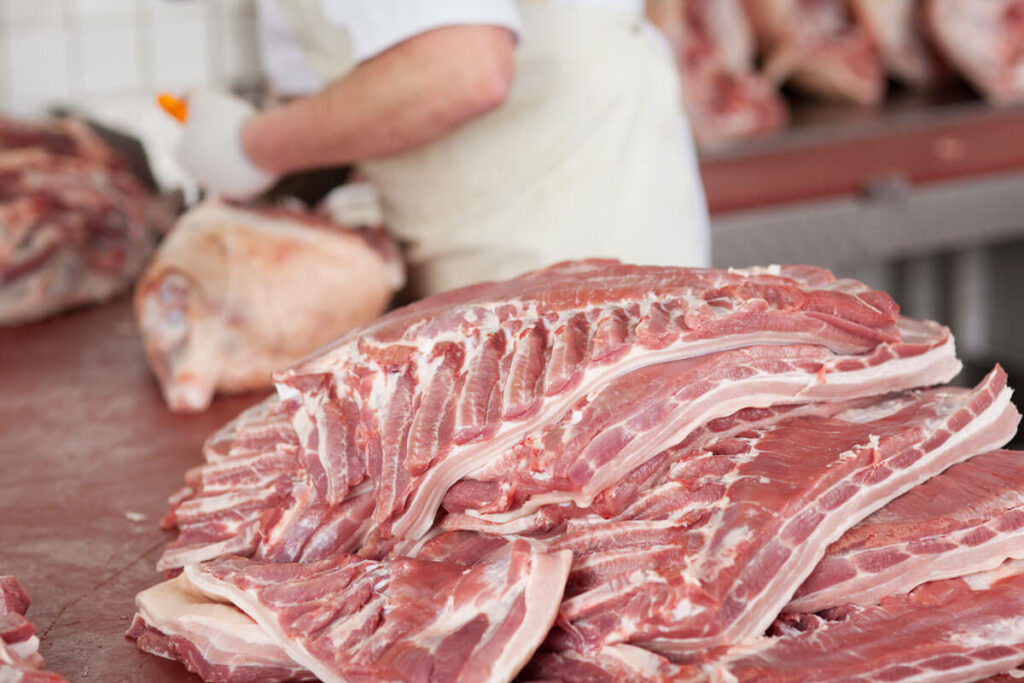
Butcher Weight & Hanging Weight
Most heritage pigs are butchered when they weigh around 180-250 lbs live. This will result in a hanging weight (meat and bones minus the head, feet and organs) ranging from 160-225 lbs.
How much meat you end up with in your freezer is totally dependent on the types of cuts you choose during processing.
It’s important to understand that heritage breed pigs grow slower than commercial pigs.
Usually heritage breeds take approximately 8 months to reach approximately 280lbs. The lard pigs take up to a year or a year and a half to reach butchering weight (which sometimes, depending on the breed, won’t be as heavy).
But commercial hogs reach 280-300lbs in just 6 months. So you can see why commercial hogs have become more popular with large farms.
For more exact information on each individual breed, download this chart from the Livestock Conservancy Organization.
Know what you want to raise pork for before choosing your breed. Many breeds are much better for things like bratwursts, sausage, charcuertery, etc. whereas other breeds are going to give you your hams, pork chops, and large roasts.
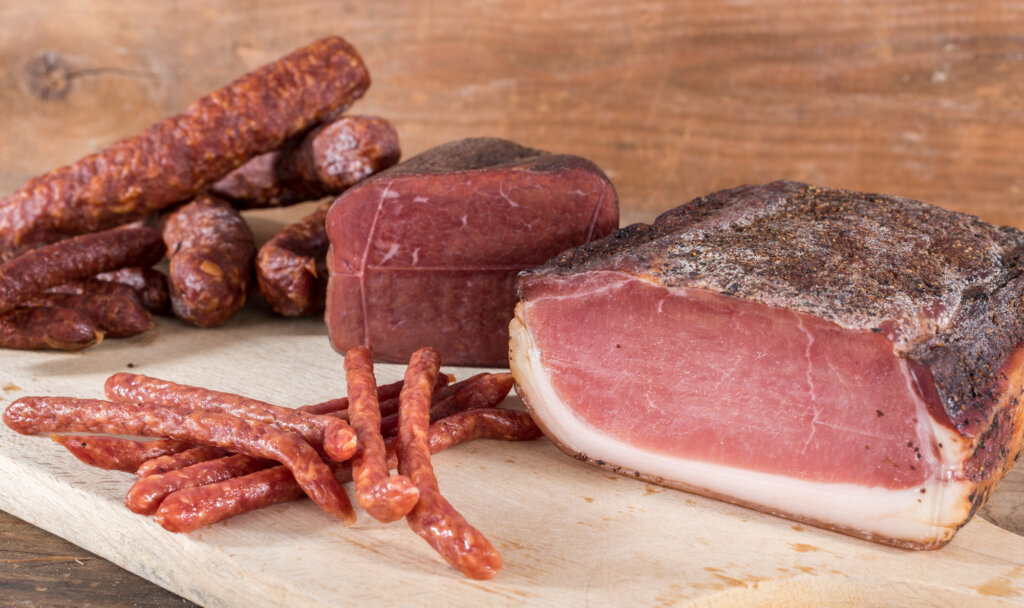
Should You Hire a Butcher?
We have butchered many a pig on our farm. Once you learn to do it its not that hard, but the first time can be a bit intimidating.
The whole process takes about 3 days. The first day is the kill and hang, the second is skinning and cutting up the pieces, the third is usually sausage processing.
A downside to butchering yourself is that unless you know how to cure bacon and ham you won’t end up with those cuts (you will have fresh ham which is really good but not like traditional cured ham).
The benefits of butchering large animals yourself is the know-how and the cost savings. Traditionally, having a hog butchered costs anywhere from $150-$250 depending on processing and curing.
Taste is Superior
By raising your own pigs you control what they eat which makes for a healthier product for your family.
Also, raising pigs is a lot of fun and I love to watch their antics. However, I find the best reason for raising pork is the taste. Once you try it you will never want supermarket pork again.
More About Amy

Amy is is a wife and mother of 18 children. In addition to parenting and homeschooling their mega family, they also run a small family farm, which they affectionately call “Autumn Creek Ranch.” They love the work of Joel Salatin (me, too!) and have patterned much of what they do by his example.
Do you have a question about raising pigs? You can email Amy at [email protected].

More About “Pork” Rhyne Cureton
Be sure to listen to the podcast (starting at minute 41) to hear about Pork Rhyne’s work in third world countries through the company EATBETA – Evangelizing Africa Through Business Empowerement in a Transformation of Agriculture.
- Pork Rhyne TV on YouTube
- Homesteaders of America
- Email: [email protected]
Melissa K Norris: Hey, pioneers. Welcome to episode number 331 of the Pioneering Today Podcast ... Today we're going to be talking about one of my favorite topics. I feel like they're all my favorite, but this is definitely high up there, and that is on raising pigs. We've covered raising pigs before in different episodes of the podcast. We've talked about the Heritage American Guinea Hog breed known ... I'm using quotation marks, even though you can't see them ... kind of as, AKA, "the homesteader's pig." My experience, in the show notes, we will link to those if you want to check out some of those prior episodes, my experience with them.
In today's episode, I'm really excited, because we're going to be diving into pigs, but we're going to be talking about a lot of common or often seen advice when it comes to raising pigs, specifically on the feed, what you are feeding your pigs, pasture management, and some other things like that that are often inaccurate, or not necessarily serving the pig and the farmer the best. Today's episode, we are going to be diving into with today's guest. I'm really excited. You'll hear, as soon as we start the interview, how I met them, a bit of the backstory. I'm going to forewarn you that, when I introduce him, don't have your volume up too loud. It's just for the first little minute. You'll get why I say that when you get there. It's all in a lot of good fun, and I think you'll actually really enjoy it and his enthusiasm about the topic.
Before I get there, today's episode is sponsored by ButcherBox, which is quite fitting, as we are talking about meat. If you're not at a point on your homestead journey yet, or you don't have a local farmer where you can purchase your meat from, then ButcherBox makes it easy to get high quality, humanely raised meat that you can trust. They deliver 100% grass fed and grass finished beef, free range organic chicken, and heritage bred pork, along with wild caught seafood, directly to your door. We have actually sampled all of the above. It has always came and been completely frozen, even when it was at the very end of the day, and the very end of the rural route that we're on for a delivery driver. We have not had any that we haven't liked. I've been very impressed with the quality, the flavor, the way that it cooks. All above the above, if it's not something that you're able to raise yourself.
One of the great things is, because you are a Pioneering Today Podcast listener, there is a special going on through January 20th. It is the New Years Bundle. You can get seven pounds of meet free in your very first box when you sign up as a new customer with ButcherBox. To snag that, go to ButcherBox.com/PioneeringToday. That is ButcherBox.com/PioneeringToday. Get your seven pounds of meat free in your first box. Thank you so much, ButcherBox, for being a sponsor of the Pioneering Today Podcast.
If you are a new listener to the podcast, welcome. A long time listener, high five. Welcome back, my friend. My name is Melissa K Norris. I'm a fifth generation homesteader, and I help thousands of people, every single month, learn how to live a homegrown and handmade life using simple modern homesteading, no matter where you're at. Today's guest is known as Pork Rhyne. His real name is actually Rhyne Cureton. I believe that's how you say it. He is known as a pork evangelist across the country, and even overseas in East Africa, which we are going to get to talk about that some. I find it very interesting and fascinating. He works as an international agricultural educator and niche meat marketing expert. For over five years, Rhyne has dedicated his life to training and educating experienced and beginning farmers, primarily on small scale livestock production, business, and marketing. We are definitely going to be talking about raising pork on a smaller livestock homestead environment, so I'm really, really excited to welcome him onto the podcast, and to talk about this.
To get links to some of the previous episodes that I mention to, and some of the things that we will be talking about, you can grab all of that at MelissaKNorris.com/331. That's just the number 331, because this is episode 331. Again, MelissaKNorris.com/331. Let's get to today's episode.
Well, I am super excited for this episode. I'm going to warn y'all. It's going to be high energy, because very few people do I meet that tend to have the energy level that I do. Without further ado, Pork Rhyne, welcome to the Pioneering Today Podcast.
"Pork" Rhyne Cureton: I'm excited. I'm excited. You brought the wrong person here.
Melissa K Norris: I don't think about wrong. I'm thinking about right. I loved your energy at HOA, so I was really glad. We were chatting a little bit before we started recording, guys, and I basically sent him an invite to the podcast that gave him no opportunity to bow out, or to say no. I basically said, "Hey, what's the date and time you want to come out to?" I'm really glad that he took my strong armed invitation and accepted. I'm really excited. I have a feeling we're going to be covering a lot in this episode, so we're just going to dive right into it.
One of the things, when we were chatting, that really [inaudible 00:06:06]. You said that you see a lot of things offered online. I'm going to assume, because I like to assume the best about everybody, that a lot of this stuff is offered with good intentions, but you see a lot of things when it comes to raising pigs online, or often, I should say, that causes problems or can be problematic. I'd love for you to dive into that a little bit more.
"Pork" Rhyne Cureton: Oh, yeah. Oh, yeah. Let's get into this. Background about me. I used to farm. Will go back into farming. Worked with the National Pork Board in Pork Checkoff. Raised heritage breeds when I farmed. Will go back into heritage breeds. I've been teaching folks how to raise pigs, both across the country, as well as overseas, over the last five years. I'm using that experience as I'm going to talk about this.
One of the things I've noticed with people who are getting into pig farming, and they've never raised pigs before in their entire life, they're most likely not even coming from a farming background, is there are a lot of problematic issues in terms of feed, in terms of land practices, in terms of animal welfare, and I daresay legalism, when we get into homesteading groups, groups that are alternative to the conventional standards and models with the pork industry. I've seen a lot of misinformation in terms of how much you should feed your pig.
Oh, man. Melissa, there is so much conflicting information. It should drive one crazy, honestly. I feel for people who are getting into raising pigs and have no idea where to start, or they go to one blog post, and then they go to a couple YouTube videos. They're getting completely different information. There's not really any consistency or continuity. Most people are looking for a formula, like, "What's a formula that I can use and be successful with?" The one myth that I want to dispel, one of the biggest myths I've ever seen, hog wash, is that there is no formula for this.
Melissa K Norris: Amen. Amen.
"Pork" Rhyne Cureton: There is absolutely no formula. Now, when you get into commercial conventional farming, there actually is a formula. If you follow it, you'll do just fine. For the heritage breeds, for people who are raising pigs outdoors, or out in pasture, or in barns, it's a lot different. There's not that consistency because, A, you've got the elements that affect how much a pig will eat. For example, when it's hotter, pigs do not like eating when they're hot. They just don't. They don't one bit. Then their ability to gain muscle mass and fat goes down because they're not eating as much. Right? When it's cold, they eat far more, because they're trying to use grain, or whatever you're feeding them, as a way of generating heat for them to stay warm. There's not really any consistency because we're not raising pigs in lab rat environments. We're just not.
One thing that I really promote is having a farmer's eye. What I mean by that is not just feeding an animal, giving it water and shelter. Not just those things, but all the contents in between that. Right? What that really requires is observational skills. You're going to make mistakes. Well, not you, Melissa, but the audience. [crosstalk 00:09:44]
Melissa K Norris: Oh, no. I make plenty of mistakes, but thank you for that.
"Pork" Rhyne Cureton: Trying not to throw you under the bus ... If you're farming and you're getting started, you're going to make a lot of mistakes, in terms of feed, in terms of housing, in terms of animal welfare, and that's fine. There's a lot of conflicting information out there, and a lot of people that are doing videos or blogs that don't have, necessarily, the background that I have, or the background that conventional pig farmer would have. A lot of people are learning from people who are just now getting started. There are a lot of people who are learning about how to raise pigs from people who have been raising pigs for one year or less. Right? The people who have been raising pigs, and even outdoors, for multiple years, five years, 10 years, 20 years, they're not online, because they're too busy making money raising pigs. That can be problematic in a lot of cases.
One thing I want to say is have grace with yourself as you're starting out and figuring stuff out. Just understand that there is no formula, and that that formula changes with the breed, with the particular type of pigs that you get. Even within a breed, there are different variations of sizes. Melissa, you raise American Guinea Hogs. There's a big [inaudible 00:11:01] riding, and there's ones that were made really small. The difference in grow out can be very drastic between those two different types within that one breed. There are a lot of nuances with breeding pigs.
Part of me now eventually starting Pork Rhyne TV is being able to have people understand that you can be successful in raising pigs within your particular context. The important thing is being flexible, being able to take constructive criticism, and being able to have observation skills, and utilize those observational skills with better practices. I've seen a lot of people that end up unfortunately falling into legalism. They're saying, "Well, this person raises pigs this way, so if you're not raising pigs this way, then you're not a good farmer." I hear that a lot. I hear a lot of people, like, "Well, if you're not raising your pigs on pasture, then you're not a good farmer." Well, I believe that just about everyone can raise pigs, and I believe that I might get some hate mail for this. I don't believe that pasture production for pigs is the only way. Right?
Melissa K Norris: Right.
"Pork" Rhyne Cureton: I've been to Africa. They've got prairies. They've got savannas. They ain't got pasture. If they have pasture, they're not putting pigs on it. They're putting cows. They're putting goats, and they're putting sheep on there. Pigs are the last thing they're going to put on pasture. That makes absolutely no sense. Also, they have two legged predators. Right? Not only do they have the four legged wild animals. They've got two legged predators, AKA humans, who actually come and steal their pigs. There is no electric netting when there are electric brownouts every day, or a couple times a day. Right? I like to look at, what's the context? What are your limited resources? What do you have? What's your experience? How much time do you have to do this?
Then, when I'm working with farmers, I just help them create their own plan within their given limitations, their given time management, their given lifestyle, and the way that still allows for proper animal welfare. There are some people who are very legalistic, within our particular sector of homesteading and farming, that end up really bashing commercial farms. Then the issue that I see is when I go to these homesteading farms. I see animals in more deplorable situations than when I see when I go into a commercial hog situation, or even when I see when I go to East Africa. Explain that to me. How can one person be bashing and sense some, yet not have proper animal welfare? That makes absolutely no sense, but this is something that I see a lot in common with people who want to have a formula for how they be successful, or want to be in legalism on there's only one way of doing something right. I truly don't believe that. I think there are multiple ways of having healthy hogs, and even a healthy family with those hogs.
Melissa K Norris: Yeah. I completely agree with you on so many things, especially with the context in looking with where you at and working within the resources, and also understanding climate, as well as workload. Until very recently, actually, I worked a day job where I was commuting. I was a pharmacy tech and was commuting 18 miles one way. My husband still works off of our homestead and farm, so he still has a day job. For us, we do have our pigs on pasture, but we don't rotate them. They're not on fresh grass every day, simply because when you leave at 5:00 AM in the morning, and it's dark, and you're not getting home until sometimes 6:00 at night, if not later, there's only so many hours in the day. I think, just like you said, that that legalistic part ... Yes, no matter what method you choose to raise your pigs, you're going to want to make sure that you are raising them as ethically and as humanely as possible, but there's more than one way to do that.
I'm really happy that you're talking about that, and also looking at your climate, because, from our experience, the American Guinea Hogs that we had, it overall was a very pleasant experience that I have. Were They Worth It?: a different episode you guys can all go and listen to on that in drawing the difference between raising the Hereford versus the American Guinea Hogs. You really need to dig into your climate with the different breeds, as well as expectations.
I wanted to circle back to one of the things, and that is feed. Feed, not only how much, as you said, and definitely your climate, and the time of year, and so many things we're going to determine. The best thing is looking at the animal. Does it look healthy? Does it look underweight? Is it looking too fat, and [inaudible 00:15:45] ... but types of feed, because, as you know, that is also controversial. Who knew homesteading could be so controversial? I swear, every aspect of homesteading I talk about, there's controversy somewhere or another. I'd love to address that, because I know this is a thing where some people are like, "Well, just go. Go to the bakery and get day old bread that they're getting rid of." Then you've got your purists. Right? There's all these things. Let's talk about them. Why is that a good idea? Why is that not a good idea? All the things. Let's dive into feeding pigs.
"Pork" Rhyne Cureton: Oh, man. You mentioned earlier of what does a healthy a pig look like? I think part of the issue is a lot of people who are starting raising pigs doesn't know what a healthy pig looks like.
Melissa K Norris: Yeah.
"Pork" Rhyne Cureton: Or how a healthy pig behaves, so that's part of the reason why I'd say, before you get your pigs, spend some time volunteering on a local farm that has the practices that you want to have, if possible. That's not for everybody. Not everyone has the time or energy. Even if it's just like, "You know what? I'm just going to spend a weekend once a month going to a farm. They might be a couple of miles away, several miles away, but I want to learn how they're doing things and get acclimated," because when you're starting out with no understanding of a strong foundation of what a good animal looks like, of what good proper feed management looks like, then you're just shooting in the dark hoping that you hit something. Sometimes that might be at the detriment of your hogs. I've heard plenty of stories. Pigs die. Let me tell you something. It's hard to kill pigs. You have to really try hard to kill pigs, but I've heard plenty of stories of homesteaders that had mismanaged their pigs so poorly that they end up passing away.
Melissa K Norris: Wow.
"Pork" Rhyne Cureton: That's extraordinarily unfortunate. That's why I say get under somebody who knows what they're talking about, not just these people on YouTube or on the blog posts, but someone who's got five years of experience, even three years of experience raising pigs, and can give you a little bit of advice and guidance. If we're starting to talk about feed, one thing, at the HOA conference, I did a whole thing about alternative feed, because I know that's what homesteaders love to talk about. They love to talk about how they're getting alternative this and alternative that, and saving money here and there. Oftentimes I've seen pigs who are emaciated, or pigs who are obese, pigs who have carcass qualities that aren't what the homesteader intended them to have. Right?
Melissa K Norris: Mm-hmm (affirmative).
"Pork" Rhyne Cureton: If you're expecting the meaty hog but you're feeding it nothing but carbohydrates, when it's time to process it, all you're getting is a really fat, obese pig. You're getting more lard than you probably know what to do with. Now, with homesteaders it's not as much of a problem, because a lot of homesteaders like to use lard.
Melissa K Norris: Amen.
"Pork" Rhyne Cureton: Amen. Thank the lard. Praise the lard.
Melissa K Norris: Yes. Yep.
"Pork" Rhyne Cureton: Praise the lard. Praise the lard. Hallelujah ... A lot of times it's like, "Oh, but I wanted more weeks. Oh, but my bacon, it's 90% fat and 2% actual muscle meat. Why is that?" I think the biggest thing is understanding what is feed? What are the components of feed? At the conference, I talked about how very simply, and I teach this in East Africa where I'm not speaking their language. I have to have a translator to do that, so I have to speak very simply. What I normally will say is feed is made out of carbohydrates. Examples of carbohydrates using feed, would be things like corn. Right? Energy source. Right? Think of carbs as energy sources. Then you have your protein source. Oftentimes a conventional feed will use soybeans as a protein source. Right? Then you're thinking about fiber, minerals, other different aspects about feed that really go a long way in terms of having a healthy quality hog.
I can say, "Oh, well, just feed 16% protein, for protein feed, that's already been milled, and feed that to your pigs." Well, that's not completely accurate because, for American Guinea Hogs, they're so obesity prone that they really need to be on an extraordinarily limited grain diet. Right? More opportunity for forage, so don't feed them a whole bunch of bread if you have lardy based pigs, unless you want a lot of fat and not a lot of meat. If that's what you want, perfect. Fine. You're doing a great job. If you're wanting more meat on your hog, but you're raising heritage, more lardier breeds, then you want to be really consistent and conscious about how much carbohydrates they're eating.
Let's say you have a meatier pig, like I would at Jason at [inaudible 00:20:44]. We had butchered a hog, and I was examining the meat quality. We talked about it, because he was really disappointed that he didn't get a lot of meat. I asked him, "Pick nine million questions." At the end of it, it came out to the fact that, potentially, his pigs were being fed organic 16% crude protein feed all the way throughout their entire life. Right? Oftentimes, when we start practicing more proficient swine husbandry, around two months to three months before the pig is going to be slaughtered, we actually reduce the amount of crude protein down to 14%. Maybe even 12%, depending on the breed. The reason why we will do that is because we want to reduce the amount of protein and increase the amount of carbohydrates, because if you increase the amount of carbohydrates, what that means is you get more fat. They'll going to store all that energy into fat. Right? If you think about people who eat meat, versus people who eat nothing but bread. One of these is going to get fatter than the other. Right?
Melissa K Norris: Mm-hmm (affirmative).
"Pork" Rhyne Cureton: That's one way of really looking at it is from that aspect, but it depends on your breed. For people who are raising, again, larder based breeds, you've got to be really mindful about how much to feed your pig grain, or anything that's floured, or baked goods. That, too. Otherwise, you'll get a lardy pig and not a lot of meat. If you have more muscular pigs like the Herberts ... I dare even say Gloucestershire Old Spots, Tamworths, Durocs, then that's not going to be a huge concern. You actually want to make sure that your pigs do gain fat before processing, so you want to actually increase your carbohydrate load before their processing date by two months. I would have enough fat cap on them to where you get flavorful, delicious pork, because fat is where the flavor is at.
Melissa K Norris: That's why we like bacon.
"Pork" Rhyne Cureton: Bacon, yes.
Melissa K Norris: Yes. That's fascinating. Speaking of the timing and the climate, as you were talking, with our Herefords, when we raise and butcher them we typically butcher in October, which means from August on we've got tons of apples around here. We actually make up an apple mash that we feed them in order to supplement the organic food that we're buying for them, and because we're butchering them in October, we've got apples all the way out to finish them. They're not a lardier breed, like you said. As you were talking, I was going back over it. With the American Guinea Hogs, we actually kind of reversed that, because we butchered them the end of January. The last two months before butcher date, we didn't have any apples left, because obviously by then we'd went through all that we had, just because of the time of year. Their carbohydrates actually got reduced the last two months before butcher. Of course, I still got massive amounts of lard.
Talking about feed and the carbohydrates, as well as their protein sources. As I said, we like to supplement with apples when we can, which is a fruit. There's fiber in there, but obviously [inaudible 00:23:58] vegetables from the garden, and all of that. When you're looking at specific protein sources other than soy, and I personally try to avoid soy. With every study under the sun, you're going to find a study that can kind of back you up one way or the other, it seems. I personally try to avoid soy, especially conventional soy, because of GMOs.
"Pork" Rhyne Cureton: Wow, you sound like you're from the Midwest. GMOs.
Melissa K Norris: Right? I can adapt accents here. When you're looking at protein sources, if you're trying to go the route of producing more of the pigs' feed on your homestead, what would be some other protein sources that one could look at?
"Pork" Rhyne Cureton: Good question. Before I even talk about, I have to say that the source of protein, if you're buying feed, is generally the most expensive ingredient in your feed bill. A, that's why when you reduce your crude protein from 16 to 14, you note that there's a significant difference in cost. It is important to figure out, what are some other ways of finding something other than soybeans? Cool fun fact about soybeans. The reason why it's so popularly used globally has nothing to do other than the fact that they were able to market the soybeans very well on the global level. That's all it had to do. There are alternatives such as rapeseed, pearl millet, the grain variety, sunflower seeds, and even field peas, that equival, if not exceed, soybeans in terms of crude protein. I think field peas are a really good way of either having food plots up for your pigs and allowing that being a source of protein. The trade off would be that you have to be really mindful of timing when your pigs enter into that food plot. I know some farmers will actually grow several acres of their local variety of field peas.
Some work better in different climates. In the Georgia, North Carolina area, iron clay peas work very well. Iron clay peas probably wouldn't work well where you're at, Melissa. They'll bale those fresh peas. They'll bale it all, and they'll make it into a silage, or something like that, that they'll feed throughout the year. That's one way that people get around that. If you're not at an efficient economy of scale, meaning that you don't have a lot of acres, you don't have a lot of machinery, it can be really challenging.
I've got one friend. He'd go to Chipotle, and he gets beans from Chipotle. That's what he does, is he gets the beans from Chipotle. Actually, he gets the beans, the chips, all the things from Chipotle, and he feeds that to his hogs. He also raised American Guinea Hogs. He never really spent a dime on actual feed. Do I recommend that? I only recommend that if it is not post-consumer. I repeat, not post-consumer. I do not recommend post-consumer restaurant scraps. What I mean by that is someone ate it, took a bite into it, threw it in the trash, and then that restaurant collected that food scraps and then gave it to the farmer. That farmer gave it to the pigs. That's a good way of spreading diseases. I don't recommend that.
Restaurants will have scraps or leftover food that didn't go to the consumer, because it's still sitting on the bar. Then what they'll do is, if you're working with a farmer, the farmer will say, "Hey, just put it in a bucket, or put it in a trash container. I'll provide the trash container for you. You just dump it out. Just make sure that there's no pork in it." Do not feed your pigs pork.
Melissa K Norris: Yes. Yes, for the love.
"Pork" Rhyne Cureton: They might give them $20 for a couple of trash cans, or something like that. Something people, they're like, "Don't even pay us. We're just glad that this waste is going towards something good and meaningful." That's a way that you can kind of do it. If you're trying to grow your own grain, your own protein source, it's going to be really challenging. That's why a lot of people just go to buy bagged feed anyway. Again, bag feed is more expensive, unless you have the acreage, or, I daresay, unless you work with farmers who have the acreage. You don't have to do everything on your own. I talk to plenty of farmers who don't have the same amount acreage that they would like to have, but they're still getting field peas, sunflower seeds, pearl millet, rapeseed, from other farmers who are nearby, and just partnering with them. That way it's more of a cooperative effort, rather than, "I have to figure this out all by myself and all on my own."
Melissa K Norris: Yeah. That's why, really, with our climate and the amount of acreage that we do have, we have purchased supplemental organic pig feed mix. We actually have a local granary mill that's about an hour away from us. That feels good because they try to source from as many local farmers as they can, and it is certified organic, which is important to me. I know that's not important to everyone, and that doesn't mean that everybody has to go that route. We do pay more for that feed. Again, that's a personal choice.
I love the suggestion of Chipotle, and the reason I love that is because they actually have a non-GMO stance, and have for a really long time. As far as looking at getting food sources outside of from a farmer, but a restaurant, even though it is a chain, that's probably one of the best ones that you could pick. I love that you gave that suggestion.
"Pork" Rhyne Cureton: Oh, great. Also, a pro tip. If you're using spent grain, just understand that 80% of spent grain is actually water. You're not getting the nutritional value out it. Spent grain, if it was dried, would have 26% crude protein. No, actually, I take that back. 29% crude protein. If it's wet, which is what people mostly get spent grain, it's only 7.7% crude protein, so misconceptions with that. Also, spent grain gets moldy very quick. I don't recommend spent grain as a primary feed source. I recommend it as an add on to an already complete diet [crosstalk 00:30:46]
Melissa K Norris: Wait. I don't even know that terminology. What does spent grain mean?
"Pork" Rhyne Cureton: You think of brewer's grain.
Melissa K Norris: Oh, okay.
"Pork" Rhyne Cureton: Brewer's grain.
Melissa K Norris: Okay. I had never even thought of going that route, but I'm glad that you made that distinction for us. I'm learning all kinds of new things. I love this. We might just have to have a part two and have you back on. See, I think that-
"Pork" Rhyne Cureton: Yes. Yes.
Melissa K Norris: Yeah, because I've got so many more things that I want to ask, but I want to try to keep this somewhat concise. My listeners know conciseness is really not a skillset that I have developed, though I am working on it. Going back to a little bit of the breeds, because I think that's where we get enamored with heritage breeds. I get it. I love heritous way. I grow an all heirloom seed garden. I love heritage, and I love being able to protect them. There's also a reason that hybrids, both in breeding programs, as well as garden seeds, have been developed. Can you talk a little bit to picking heritage versus other breeds, and then within heritage breeds? I know this could be an entire complete episode all on its own, getting into this. Within the heritage breeds, certain things to consider when you are picking a heritage breed, if that's the route you choose to go.
"Pork" Rhyne Cureton: I love it. Yeah, let's get into that. With heritage breed pigs, some background on me, my first pigs were heritage breed. They were English Large Blacks. There's something about those Large Blacks. They're the black pigs with the super floppy ears. They look extraordinarily adorable. You can't see their eyes because their ears are covering it. Then Red Wattle. Then I've raised crosses, some of them heritage variety, the Hampshire and Duroc, as well as commercial Yorkshire. I'm grateful that I've had those different experiences. I've even bred, both purebred, as well as hybrids.
One thing that I'll say with heritage is that there's a reason why they're heritage. They do extraordinarily well in low input situations. What I mean by that is 100 years ago, 200 years ago, 300 years ago, these pigs were not being fed a strict grain diet. I'll repeat that one more time. They were not pampered. They were not pampered pigs that got fed a strict grain diet. They just weren't. They were getting fed any old kind of thing, from house scraps, slaughter waste. Then, once fields were harvested, they'll send the pigs out to clean up the fields. Right? Pigs were low input animals, just like chickens. That allowed for a lot of people to be able to have a meat source that was low input, meaning that that was saving them money. In fact, pigs used to be able to ... We can't say this so much today, but they used to be able to really be a life saver for a lot of families when crops failed that year. At least they had pigs to pay off any bills, their mortgage. Whatever it might've been.
One of the issues that we have today is that we have switched more to a commercial hog. Part of the reason of that is because somewhere around the, I believe, 40s, 50s, or 60s, somewhere in between there, there was a crisis on heart disease. People were trying to out what's causing heart disease. It came down to two things: sugar related products, and fat related products, including fat industries. Unfortunately, there was some falsified information, and sugar ended up winning. Fat ended up being the blame for heart disease. What ended up happening with that was ... That's why you have yogurt that's low fat. It literally says low fat, but like 12 grams of sugar in a cup. People don't understand that sugar, when not utilized properly, converts to what? Fat.
Melissa K Norris: Yes, and insulin resistance issues, and so many different things.
"Pork" Rhyne Cureton: Keep preaching, Melissa. Keep preaching. That's part of the reason why a lot of these animals went out of favor. They also went out of favor because, around the Industrial Revolution in this country, we realized that we can produce synthetic oils, cheaper vegetable oils, as a way of machinery. We were using whale blubber to oil trains. Now we're using more synthetic oils to be able to use machinery. That's another reason why pigs also went out of favor. Also, these pigs grow very slow. In terms of homesteaders, if you're getting heritage breed pigs, they will grow slower than your commercial pigs. Usually commercial hogs are ready at around six months, and they weigh somewhere between 280 pounds to 300 pounds. Usually around 280 at six months. Those are for your commercial hogs. Now, when you get a heritage breed, you do have some variation. Your Herefords ... What other breeds are there other than Herefords? Your Tamworths. Other more meatier breeds. Usually they're at 680. Sorry, 280, if not 300 by eight months. Right?
Melissa K Norris: Mm-hmm (affirmative). Yeah.
"Pork" Rhyne Cureton: Usually I'll say grow them out for an additional two months to get more back fat on them. Then you have your lard pig like your American Guinea Hogs. That can take a year to a year and a half, depending on the particular type of American Guinea Hog. English Large Blacks can take 10 years. Sorry, 10 months, to a year, a year and a half, to reach around 260. Right? There are a lot of different variations with the breeds. I highly recommend, if you want more information on the comparisons, just look up heritage hog breed comparisons chart. You should be able to find that at the LivestockConservancy.com. Sorry, .org. That'll give you way more information than you probably want to know on each individual breed from that standpoint.
Another thing to consider is, with heritage breeds, the medium breeds do very well with retail cuts. However, that's where they shine, because they provide more muscle mass. That's great. With your lard based pigs, like your Mulefoot, your English Large Black, your Kunekunes, your American Guinea Hogs, they weren't made for, necessarily, meat production. They're made really more for fat production, with fat actual more valuable than the pork itself. They really shine in sausages and ground pork. They shine very well in charcuterie. Part of the reason why a lot of people who are raising lard based pigs are having issues with marketing their pigs is because they're marketing as if they're retail hogs, and they're not. They're absolutely not. They need to be marketed and treated a lot differently.
Again, fat is where the flavor is at. When you're doing bratwurst, no better bratwurst than a lard pig bratwurst. That's the best bratwurst you'll ever have. Best sausage you will ever have. Best charcuterie you're going to ever have compared to your more leaner breeds, even on the heritage side. If you're raising these heritage breeds, especially the large ones, start thinking outside of the box from retail cuts, because if you try to make pork chops out of an American Guinea Hog, your pork chops are going to be small. Your-
Melissa K Norris: You got sent lots of fat.
"Pork" Rhyne Cureton: A lot of fat. [inaudible 00:38:51] going to be extremely tiny. You can probably put a pencil through that. Think about it from the standpoint of I can sell these pigs, wholes and halves. I can turn them into charcuterie. I can turn them into ground pork and sausage, and maybe keep the bacon, depending, and hams. Hams, if you're going to use ham charcuterie as well. They don't shine well with pork chops. They don't shine very well with leg roasts, or Boston butts, or sometimes even bacon, or pork chops. They don't shine well doing those things, so stick to the shrimp of the pigs.
When I used to work for the Livestock Conservancy, I did change some of the utilization descriptions for the breeds. If you go on their website, LivestockConservancy.org, and look at the breed profiles, on the side you should be able to see the utilizations for those breeds. They should be up to date, because I did update them before I resigned from there. Those are my thoughts on that.
Melissa K Norris: Okay. Awesome. I love that, because the American Guinea Hog was the best bacon we've ever had, bar none. The ham was fatty, but when I cooked it in the slow cooker, and then shredded it. Oh my gosh. It was amazing, but it's not like a spiral cut, when you think of spiral cut hams. That is not what you were getting. I'm with you there, definitely. If you we raise the American Guinea Hogs again, I probably will just raise them for the bacon, and the sausage, and a couple of the ham cuts. We won't even bother with the pork chops. I have to say, the pork chops were delicious because of the fat, and quite moist, but yet you're getting such little meat per pork chop cut. I almost have to cook six for our family of four just to barely get enough meat for everybody. I'm really glad that you brought those points up. It's kind of like, do we get a couple of American Guinea Hogs just for the bacon and sausage, and then raise the Herefords? I don't know. We'll see what we end up doing.
Some amazing resources in today's blog post that accompanies this episode. We will provide all of the links and different things that Rhyne has been so gracious to point us in the direction of. One of the things you had mentioned that I wanted to talk about and just, myself, learn more about, is your work in Uganda with raising pork. Can you tell us a little bit more about that? I find that fascinating.
"Pork" Rhyne Cureton: Yeah. Yeah, definitely ... I lost my train of thought.
Melissa K Norris: It happens.
"Pork" Rhyne Cureton: I go overseas to East Africa, Uganda, as well as Tanzania, or Tanzania if you've got a country accent. I teach people, basically, in very simple manners, how to raise pigs within their context. I'm really blessed by that experience, because it allowed for me to really look at farming more contextually ... I made a rookie mistake. I remember my first year going. I go into an organization called EATBETA. It's E-A-T-B-E-T-A. It stands for evangelizing Africa through business empowerment and the transformation of agriculture. We're not simply about giving money to people. We're about how do we train and educate people on best practices with their business and with their farm.
One slogan that I use when I go over there is farming is business. Farming is business. I don't care if you're in it from subsistence living, or if you're trying to make money off of it. It's always a business, because you're having inputs, and there are outputs. Right? Usually that requires some type of economic or capital to be able to make that thrive. When I go over there, I'm working within their context. They don't say soybeans. They say soya. They don't say corn. They say maize bran. They're having limited ingredients and limited resources. They're using different even feed additives like sunflower seed cake, and fish meal, and all these other things. Being able to understand that not all of them are at a place where they can raise healthy pigs, it's really important. It's even sad sometimes when I have to recommend that they not raise pigs, because they're not at that scale.
I daresay, even to your audience, you might not be at a scale where it's economically viable for you to raise pigs. I want to let you know there is no shame in that. Absolutely no shame in that. Stick to chickens. Grow that chicken operation out a little bit more, whether it's egg production or meat birds. I recommend meat birds, and scale up from there. That's what a lot of people have done to really be successful with raising pigs. They start out small. They start out with chickens, and then they build up to pigs, and then they'll build up to cattle, or maybe the goats and sheep. That's probably a really good model for East Africa is showing people that you can scale up your farming operation. You have to do it incrementally. A lot of people who are philanthropists will just donate tractors to East Africa. Right? These people don't know how to use a tractor. Most of them don't. When something breaks down, they can't fix it.
When my team goes down there, we're not teaching how to use a tractor. We're teaching, how do you hand plow? How do we get you from a hand plow, or hand hoe, to a hand plow, where you're actually tilling the Earth through a hand mechanized plow? We're doing funding for that, and we're giving those out. It's appropriate technology, appropriate training and education, rather than we're just going to give money, rather than we're just going to fix all your problems. No. We're going to teach, how do you run a business? When I go over there, I teach farming is a business, and I teach people that animal welfare, because there are a lot of issues with animal welfare in countries that would be deemed third world or developing. People over there don't treat pigs like pets. They treat pigs like stupid dirty animals.
Part of what I do is I teach animal welfare is not necessarily the primary goal. The primary goal is economics. The primary goal is making money. Well, if I know that their real issue is they want to make money, then I equate proper animal welfare with higher profitability. For example, if you are putting your pig on a more standardized feed ration, your pigs grow out faster, meaning you get your money quicker. Very simple and easy. Right? If I talk about how reducing your herd if your herd is unmanageable, you have too many pigs, and you can't afford to have too many pigs, by reducing your herd and just sticking to a few and feeding those well, it increases your reputation. Now, you're having pigs that are actually at weight. People are getting that pork, and they're getting the quality pork that they're wanting, rather than emaciated pigs. Right? That increases reputation. That means comeback customers.
When you're dealing with breeding, thinking about when you're really treating your sow with respect. Not beating it. When you're really giving your sow enough water, enough feed rationing, then that allows for you to have healthier piglets. That allows for your piglets to be weaned to survival, and then that means more profit per pig. Right? Everything really can boil down to economics when I go over there, and that's allowed for me to translate that back to the states, and really show people that every decision that you make as a farmer has an economic impact. It will always have an economic impact, whether big or great, or small or great, small or great.
That allows for a lot of people to see that their decision to switch feeds, that's an economic decision. Can you afford to do that? If not, that's okay. There's no shame. Or I want to do this opportunity with sausage, or opportunity with a live event. Okay, cool. What's the economic impact on your farm, and how much money will it cost? That really gets people thinking about, "How do I save money, or how do I reduce my costs, or how do I become more profitable in the enterprise I already have?"
Melissa K Norris: Wow. I love all of that. That, again, is an entire 'nother episode. We could probably talk for hours and hours and not get through everything, but this was great. I really enjoyed it. Would love to have you come back on. For those who are wanting to learn more about you, learn from you, check out more about your farm and the work that you're doing, what's the best place for people to connect with you?
"Pork" Rhyne Cureton: People can connect with me on ... People have been begging me to start a YouTube channel, and I resisted it for, I think, about a year. I recently have made a channel, and I'll be posting videos on it by the end of this week. Whenever you have this recording out, I will have already posted videos. That's the best way.
Melissa K Norris: Okay.
"Pork" Rhyne Cureton: I am considering leaving Instagram, so I won't be on Instagram. Then, for emails, you can email me at Rhyne, R-H-Y-N-E, @PorkRhyne, P-O-R-K, R-H-Y-N-E, .com.
Melissa K Norris: Awesome. Now, I know Rhyne is your first name, but my great grandmother's last name was Rhyne. I just had to throw that fun little tidbit out there. Spelled exactly like yours.
"Pork" Rhyne Cureton: Cool. We're long lost cousins. That's all it is.
Melissa K Norris: Yeah, I agree. This has been a blast. I can't wait to learn more from you, and just be able to share that knowledge to get more people raising more of their own food, and taking control of their food source. Thank you so much for coming on today.
"Pork" Rhyne Cureton: Amen. Amen. Glad to be here, and I appreciate what you're doing with your podcast and your YouTube channel. You're one of the few folks in that space where I don't cringe when I watch a video, so just thank you for the good work that you're doing, and the honesty that you have behind it. It really means a lot to me.
Melissa K Norris: Aw, thank you. I hope you had as much fun as I did with today's episode and picked up some tips if you are planning on raising your own pork, or maybe you already have pork, but you were able to glean some tips and some ideas on where you could get some extra feed without a bunch of extra expense, which I know that always gets me super excited when it comes to our homestead endeavors. Well, this episode was all about raising pork, or mainly about raising pork.
Next week, I have another really fun episode for you where we will be having a guest, and we will be talking about homesteading, but, in particular, gardening. Especially if you have young children, or children at home, how to get them incorporated, but also still how to have a garden and try to stay sane. If you have infants, or toddlers, or really young children, it can often be hard trying to juggle it all. We are going to dive into this. I had so much fun doing these episodes. I know you're going to enjoy them just as much as I do. That is coming up for you next week. Blessings and mason jars for now.
Sign up to receive email updates
Enter your name and email address below and I'll send you periodic updates about the podcast.
Other Articles You May Enjoy
- Planning Your Livestock for a Year’s Worth of Meat Per Person
- Our Food Production Plan & How to Plan for Livestock
- 5 Tips on Raising Livestock for Food
- Decoding mRNA in Meat
- Keeping a Family Milk Cow- 8 Things You Need to Know
- A Guide to Raising Goats
- Everything You Need to Know About Raising Rabbits for Meat
- How to Keep Animals Cool in Hot Weather
- Maximizing Your Homestead for Profit & Production (With Joel Salatin)
- Commonly Believed Homesteading Myths
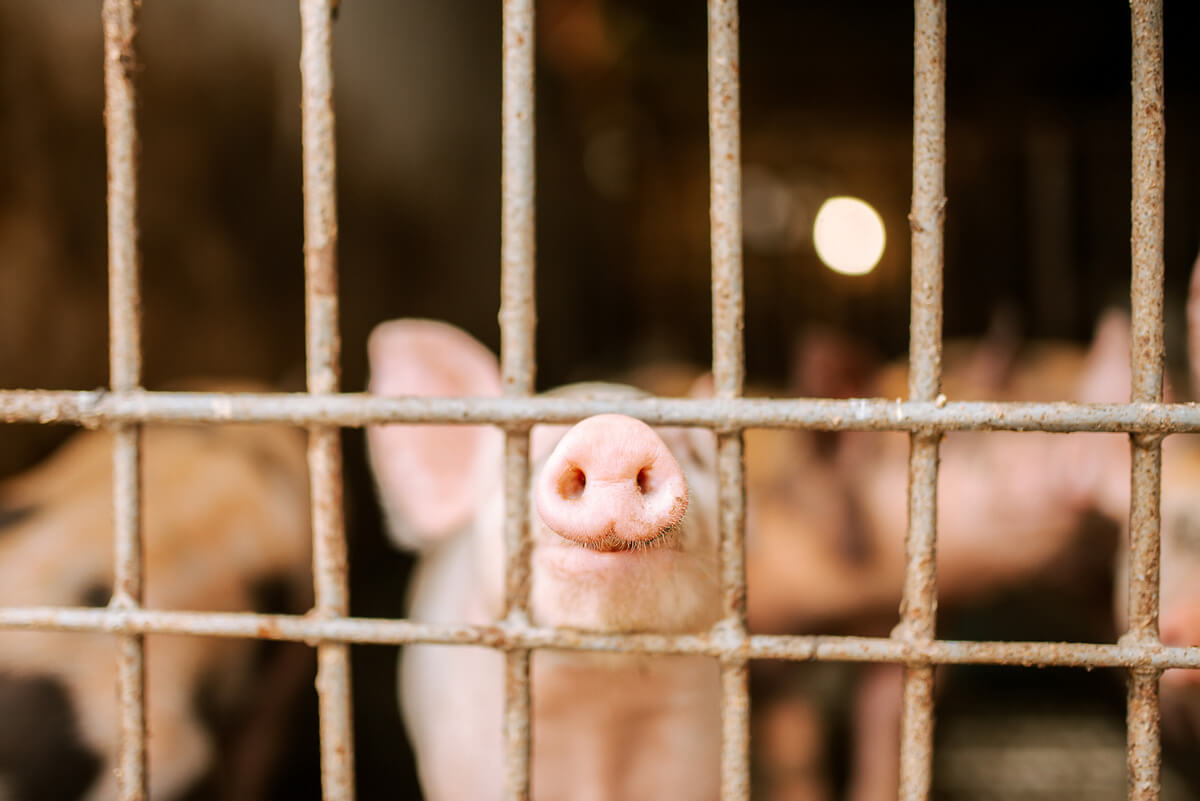
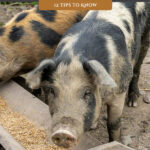
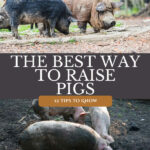
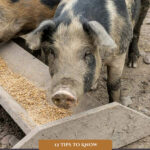
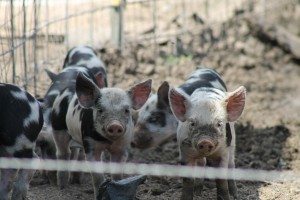

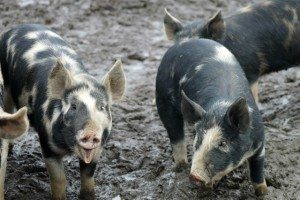
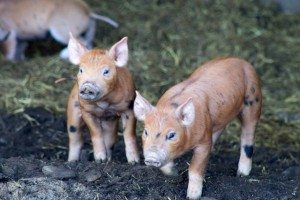

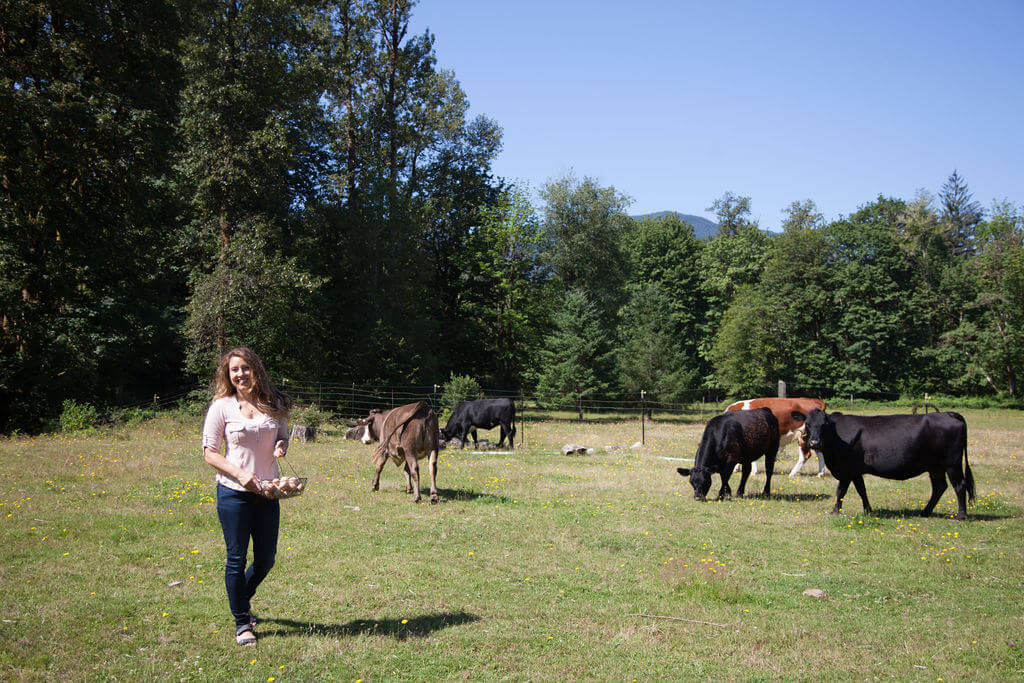
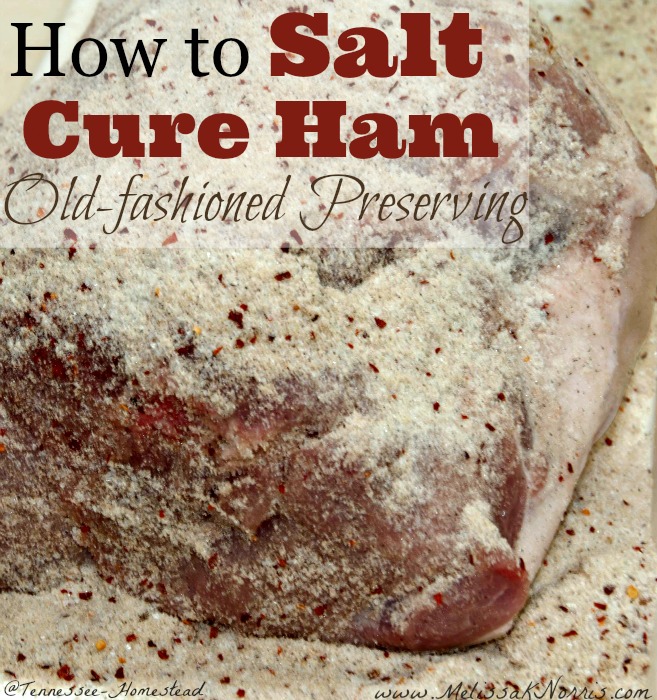
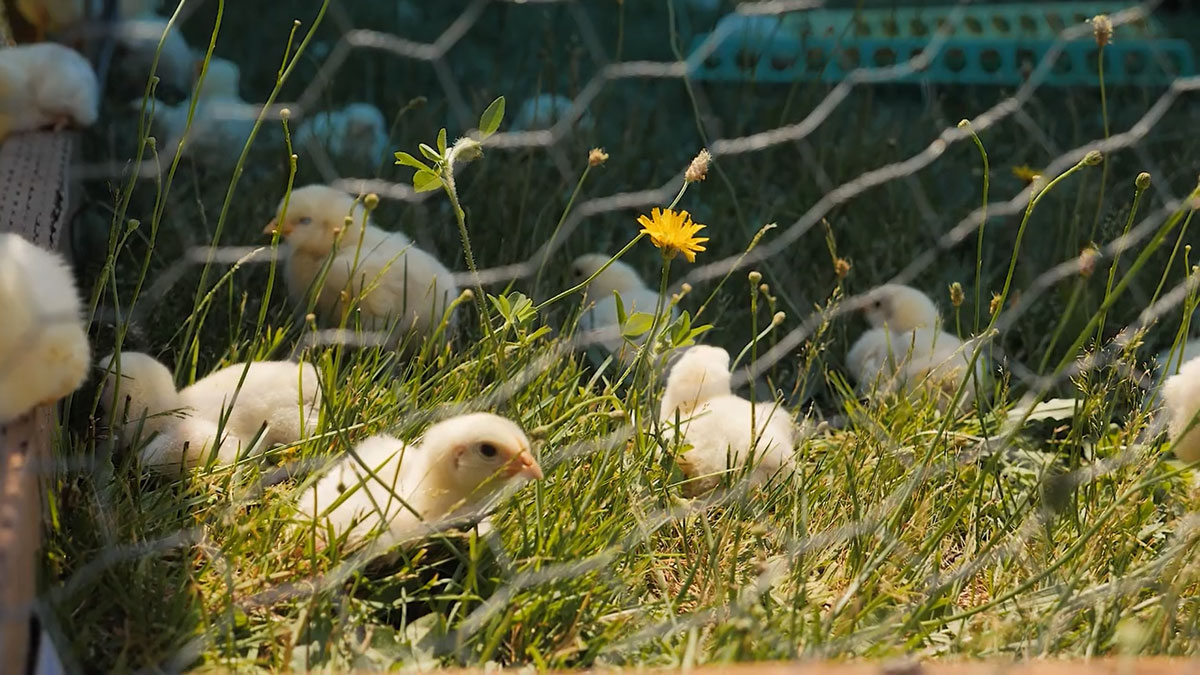

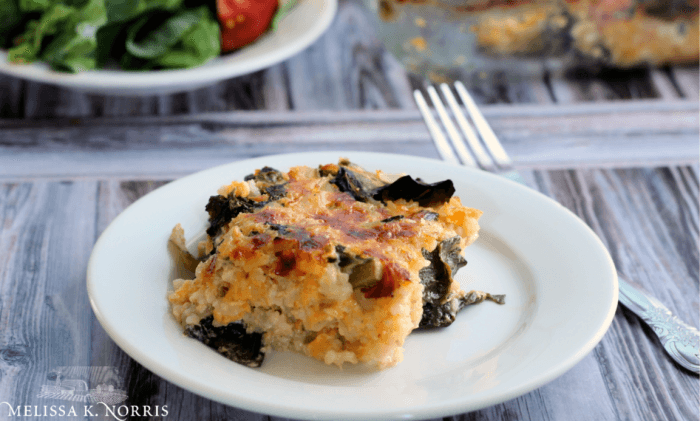


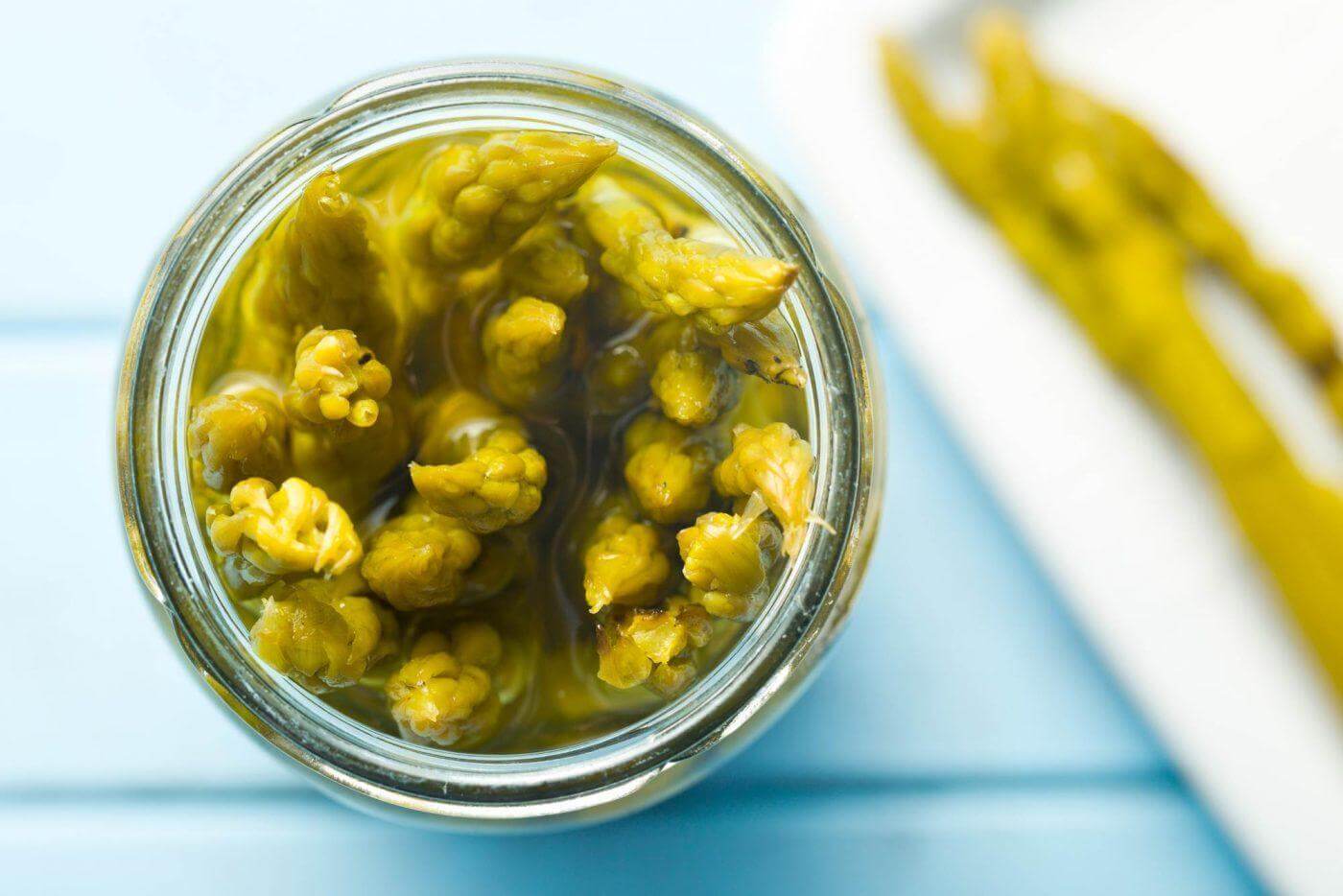

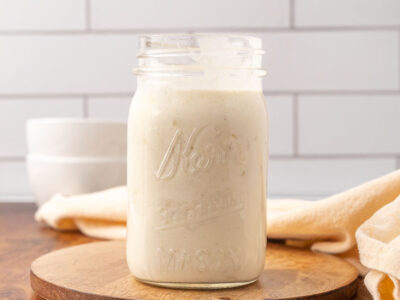
I’d like to know how to perfectly raise pigs. Please help me.
Thank you so much for your article. Very informative! I was wondering if you can raise two female piglets together and not have a bunch of fights? We will be Using a Horse stall to raise them in. The inside is 13 x 13 and the outside area is 13 feet wide and approximately 30 feet long. Will that be enough for two little piglets to grow up in?
Thanks for the information
very interesting and l know how to raise pigs.
18 children. Wow, my hats off to you.. 5 was enough for me. Thanks for the tips on pigs. Raised them on the farm when I was a child , but I was not really involved in the process.. I started with 2 this year and it certainly is a learning experience. That meat better taste really good, because I’m not sure how cost effective this venture with turn out.. thanks again. Best regards, Robert
We are considering converting our chicken mansion into a pig pen. It is a 8×16 foot structure with metal roofing and 1/3 of it has walls and the other 2/3 chicken wire. Do you think this structure would be sufficient? Or do we need to add a larger gated pen around it? We would like to not only feed them as healthy as possible, but let them live humanely.
#1 thing you can do to TRULY improve quality of meat is to give them ROOM to move around. We gave our 4H hogs a full acre to move around in & the quality improvement of the meat was SHOCKING. We did it because we had the room. We did nothing else different than standard approach. We didn’t find out until later that that was the big improvement factor.
Thank you for all your valuable information. My husband and I are starting the adventure of raising our own pigs for meat and this was very helpful.
Thank you!
New to raisin hogs I’m about to be ready to bring my hog to the bucher. Is there anything special that i need to do before they go like feed wise or anything
What minererals do you use for the hogs?
Amy, thank you for the info. I would love more homesteading info. Do you have a newsletter or something similar.
I’m wondering how to market your raised pigs.
How much area do I need to fence for like 10 to 12 pigs area like two areas are three to have a garden area and then move them to another area
For 10 to 12 pigs you’ll need a decent sized area. Rule of thumb is at least 50 square feet PER pig.
Thanks for your assistance in pig breeding
Putting the pigs into your garden area implies that the pigpen is nearby. Do you have any problems with then trying to get into the garden during the summer growing season? I envision a group of hogs planning a jailbreak for fresh corn.
When the pigs are piglets we kept them near the garden to till up new ground for expanding the garden. Once they’re larger, we move them to the pasture. We’ve never had them get into the garden.
Hi, Thanks for the great article. I notice you start in the spring and butcher in the fall. Is it ok to buy in the fall or is it more expensive to raise through the winter months?
Just bought a mini farm and want to raise my children with chores and understanding where their food comes from.
Excited to get started.
Thank you,
Bobbie
Pigs need heat during the winter months and you’ll spend more on feed, plus they use more of their food to keep warm than they do growing so most folks do spring and butcher in the fall.
Helpful… Thanks..
I love your tips and I wish to become a pig farmer
Have you ever heard of trembles? We bought 4 pigs and 1 seems to have them? We were told she had some trauma when they seperated and weaned from their Mom.
we started to raise american guinea hogs, love this breed very docile friendly..we have a litter of 4..and just on july 30 another 3..no bites on selling any..do you have any suggestions.. i put ad in shoppers guide and craigslist not one call…i have never tasted meat of them yet..what are you raising and any hints you can give me..thanks have a great eve…dennis
Hi – we are raising two pigs for the first time. What herbal de-wormer have you been using? We don’t want to use the chemical de-wormers on the market.
what percentage of profit would raising 10 pigs bring me after spending most of my money on feed and other necessarry stuff..? am a begginer and i want to know how worth.
That depends on how much you spent on the pigs, your feed costs, and the going market rate in your area.
Thanks a lot for sharing , wish you can come over here in Uganda and educate us on how to keep pigs..I have about five so far but I really want to make it a real business
As a child on the farm, we had pigs, we scraped the hair on the pigs when butchering them.
My son got a pig & he skinned it, that was a first for both of us.
We do not have a butcher house, so he took the meat to a processor.
Who told us about the Brucella which causes Brucellosis.
We got over 200 pounds of finished meat.
Thanks for sharing. We just got our first 3 pigs. So much to learn but, you have been very helpful.
18 children ,
buy a tv!!!
wow congrats given.
home schooling, great our public schools are a mess
and my guess is God is also taught!!!
18 kids…..a really great family experience for parents and kids. Like to see a future president of America comes from T the familly!
When you say that you feed the piglets 5 pounds of feed per day, is that per piglet?
What is the brand of feeder that you use? Where can I buy one?
Hi Amy, we are raising our first pigs this spring. They will be 8 weeks when we get them. Live in Oregon, weather has been cold this year. Do we need to use heat lamps or are they old enough to be in outdoor pen
Cathy, how early are you getting your pigs? We live in Washington state and get ours the end of April. We don’t use a heat lamp at that time, but we make sure they can have a small stall (we use pallets to create a three sided shed with a roof) and straw so they can burrow in with one another and stay warm.
I did not realize that it was so important to feed your animals the right foods so that they grow correctly. The idea of demand feeding seems like a good way to keep the workload light and to help your animals grow as big and strong as possible. When raising animals for food, the kinds of food that they intake becomes a very important subject. Like you said, raising animals on your own makes the food much more enjoyable and healthier for your family.
What kind of pig do we buy?
We’ve been raising Hereford pigs for five years now and really like them.
Used to raise pigs when I was young. I still dislike most commercial pork as a result. You just can’t beat home-raised. Here’s a secret ingredient: sing to the pigs. They love the music and attention, and it helps keep their stress levels down.
I need information how to butcher pigs.
Thanks for a great article. I have been thinking about creating a homemade ration for our piglet. Would you mind expounding on this? Thank you!
Thank you for the easy to understand tips. I am hoping to start raising a couple of piglets next spring.
[…] 2. Buy 8-week-old Piglets […]
WE HAVE FAMILY THAT WANTS US TO SHARE THE COST OF THE PIGS THEY HAVE RAISED TO EAT !! ITS THE FIRST TIME, FOR THEM !! DO I HAVE TO WORRIE ABOUT IS THE MEAT SAFE TO EAT ?? CAN WE GET SICK ?? WE ARE 75 YEARS OLD !! THANKS GAIL
Gail,
As long as the meat is handled properly at butchering time it should be fine. We use a natural herbal wormer for our pigs. I’d ask them questions about the practices they’re using with the raising if you’re concerned.
Hi – we are raising two meat pigs for the first time. We are hesitant to use most de-wormers on the market. What herbal de-wormer do you use?
Is there a big difference about the weight of the pig when they travel from 1 place to another. .
This refer to when we sell the pig live weight basis. Thanks
Hi Melissa, I like the way you use God and Scripture in your books, podcasts and your website and Pioneering Today Academy. Leviticus chapter 11:7-8 reads and the swine though he divide the hoof, and be cloven footed, yet he cheweth not the cud he is unclean to you. Of their flesh ye shall not eat and their carcase shall ye not touch; they are unclean to you.
There are several verses in the New Testament (that’s the covenant I’m under) that I go by. This is something many people like to debate but for me and my house, we believe there are plenty of verses that don’t require sticking to the kosher outlines of the Old Testament for eating (just like we don’t make women isolate when they menstruate or call them unclean).
Matthew 15:17-20
“Do not ye yet understand, that whatsoever entereth in at the mouth goeth into the belly, and is cast out into the draught? But those things which proceed out of the mouth come forth from the heart; and they defile the man. For out of the heart proceed evil thoughts, murders, adulteries, fornications, thefts, false witness, blasphemies: These are the things which defile a man: but to eat with unwashen hands defileth not a man.” KJV
Mark 7:15-19
“There is nothing outside the man which can defile him if it goes into him; but the things which proceed out of the man are what defile the man. [” If anyone has ears to hear, let him hear.”] When he had left the crowd and entered the house, His disciples questioned Him about the parable. And He said to them, “Are you so lacking in understanding also? Do you not understand that whatever goes into the man from outside cannot defile him, because it does not go into his heart, but into his stomach, and is eliminated?” (Thus He declared all foods clean.) NASB
1 Timothy 4:1-5
“Now the Spirit speaketh expressly, that in the latter times some shall depart from the faith, giving heed to seducing spirits, and doctrines of devils; Speaking lies in hypocrisy; having their conscience seared with a hot iron; Forbidding to marry, and commanding to abstain from meats, which God hath created to be received with thanksgiving of them which believe and know the truth. For every creature of God is good, and nothing to be refused, if it be received with thanksgiving: For it is sanctified by the word of God and prayer.” KJV
Thank you so much for sharing all of this information. I’m going to be getting a pig or two in about 8 weeks and I’m looking into feeding them as healthy and cost effective as possible. I was wondering if you sprout the peas and barley mixture you mentioned. And I’m also wondering what swine minerals you use. Yours is the only article I’ve found so far that mentions milk in the diet and no commercial feed. Id love if you could share any more advice and info 🙂
Thanks so much for the info of raising your own pig..we are in the middle of it now…good to know I’m doing a pretty good job.
What is your opinion on feeding non GMO corn? I’ve been doing good that along with a pig feed and fresh veggies and fruit from the garden
Bobbie,
If it’s nonGMO corn than I think it’s fine to mix in with their feed. I like to have a balanced mixture of things we feed, so fresh veggies and fruit are awesome!
I need info on how to raise pigs for business. I have started with 2 a boar and a sow of the same family. They are 3 months old.
I’m aseu Michael from Uganda I have started small piggery farm but I have like much of your profile I would like to get more advice from you on how to run piggery farm.because my target is to be one of Uganda’s largest piggery farmer but I need alot of support advice from the experienced farmer’s
Thank you ! I just bought my 2 acre farm last February brought our first two feeders home today. They are7 week old yorkshire and Duroc cross and appear to be extremely healthy.
I want to do the best by them. Your artical is very simple and easy to understand. i will be following your suggestions. Again< a huge Thank You!
Is there a risk for bacteria in the garden area if you allow the pigs to stay there over the winter? I am very interested in moving them around, if possible! Also, we live in a very hilly area; what are your thoughts on letting them run up and down the hills?
You’re welcome Tessa! Ossabaw is a heritage breed isn’t it?
Amy very first time trying to raise anything need all the knowledge i can retrieve
Thank you for all these tips, Amy! We’re getting some Ossabaw pigs this August and this will be our first venture into pigs. So much to learn and this was so helpful!